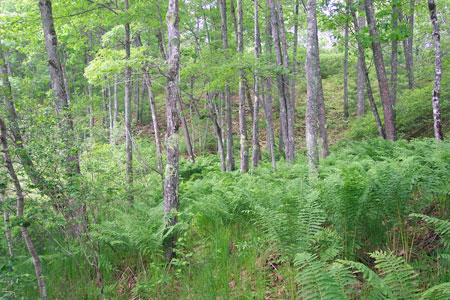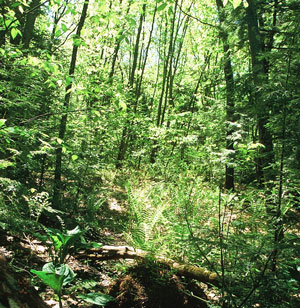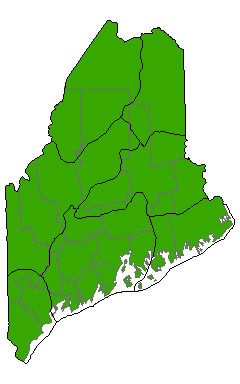DACF Home → Bureaus & Programs → Maine Natural Areas Program → Communities, Plants, and Animals → Natural Community Fact Sheets → Hardwood Seepage Forest
Printer Friendly Fact Sheet - 900 KB pdf (Get a free copy of Adobe Acrobat Reader)
Hardwood Seepage Forest
Scientific Name: Hardwood Seepage Forest; State Rank: S3

- Community Description
- Soil and Site Characteristics
- Diagnostics
- Similar Types
- Conservation, Wildlife and Management Considerations
- Distribution
- Characteristic Plants
- Associated Rare Plants
- Associated Rare Animals
- Examples on Conservation Lands You Can Visit
Community Description: These closed canopy to partial canopy forests support a mixture of mostly deciduous overstory trees. Yellow birch, red maple, and/or green, black, or white ash are usually prominent species (35-85% cover each, sometimes lower). Hemlock or, less often, red spruce may create a mixed canopy (>25% conifer), with locally dense conifers. Sugar maple, beech, and red oak are occasional. The understory is usually open, with few shrubs and patches of tree regeneration. The herb layer is typically patchy, and reflects the underlying seepage gradients. Skunk cabbage, jewel weed, sensitive fern, and cinnamon fern occur in the wettest areas, and species less restricted by soil moisture occur elsewhere. Bryoids are sparse. Back to top.
Soil and Site Characteristics: Sites occur on slight slopes (<15%) and adjacent bottoms where an impervious soil layer (~30 cm deep), such as marine clay or packed till, forces seepage water near the surface. Sites often occur at breaks in slope – either at the base of a slope, or on a slope bench. Soils are loamy, or grading to silty in flats, and moderately acidic to neutral (pH 5.2-7.0). Soils place this as a wetland type, but some sites may grade from wetland to upland as one moves upslope. Small sites, or ‘forest seeps’ (i.e., less than one acre) are frequent and are typically considered as inclusions within the broader forest rather than distinct natural communities. Back to top.

Diagnostics: Ash and/or yellow birch are common in the canopy (red oak is prominent at some sites). Red maple may be present but is not dominant. Wetland species are common in the herb layer. Soils are saturated and often temporarily flooded. Back to top.
Similar Types: Pocket Swamps feature hemlock and/or red maple as dominants, have heaths or winterberry in the shrub layer, and typically occur in distinct basins. Some Enriched Northern Hardwoods Forests may have areas of wet soils, but have very different herb layer composition. Red Maple Swamps can occur in similar settings but have different canopy composition. Back to top.
Conservation, Wildlife and Management Considerations: Many sites are on land with a long settlement history and have been either cleared or harvested in the past. Because these tend to occur as small forest patches, their conservation depends in part on maintaining some surrounding forest cover (both upslope and downslope) as a buffer. Like vernal pools, recognition of this type is more difficult in the winter, when snow cover and plant senescence may make it difficult to distinguish these sites from upland forest. Seeps may remain unfrozen through the winter, making it difficult to operate logging equipment.
Birds using a variety of hardwood types may use these communities. Cool, well oxygenated forested seeps provide habitat for the northern spring salamander. Occurrences of this community type in southern Maine may host the rare spicebush swallowtail butterfly, whose larvae feed only on spicebush and sassafras. Back to top.
Distribution: Statewide, though not well documented. Landscape Pattern: Small Patch. Occurrences less than one acre are generally considered inclusions rather than distinct natural communities. Back to top.


Characteristic Plants: These plants are frequently found in this community type. Those with an asterisk are often diagnostic of this community.
- Canopy
- American beech
- Eastern hemlock*
- Green ash*
- Red oak
- Red spruce
- Sugar maple
- Yellow birch*
- Sapling/shrub
- American beech
- Red spruce*
- Herb
- Bluejoint
- Cinnamon fern*
- Common speedwell
- Goldthread
- Jack-in-the-pulpit
- New York fern
- Sensitive fern*
- Spinulose wood fern
- Bryoid
- Dicranum moss
- Sphagnum mosses*
- Northern spring salamander
- Spicebush swallowtail
Examples on Conservation Lands You Can Visit
| Example | County |
|---|---|
| Dickwood IFW Lot | Aroostook Co. |
| Sears Island | Penobscot Co. |